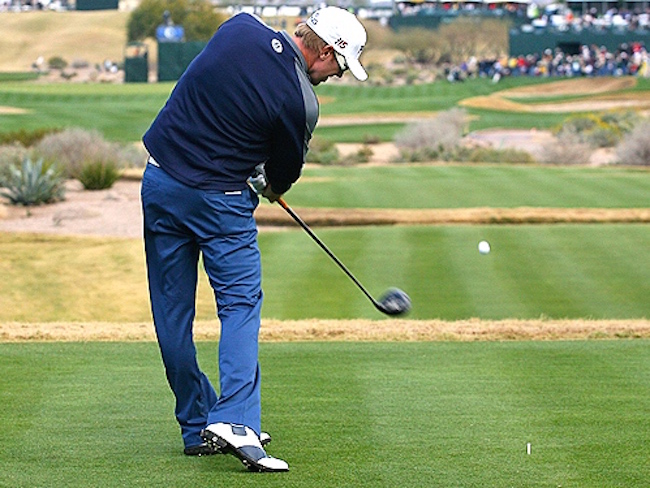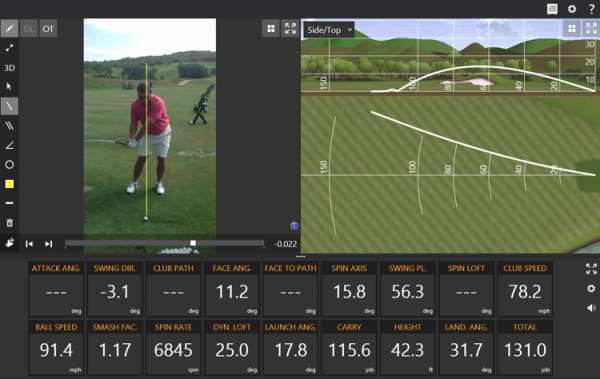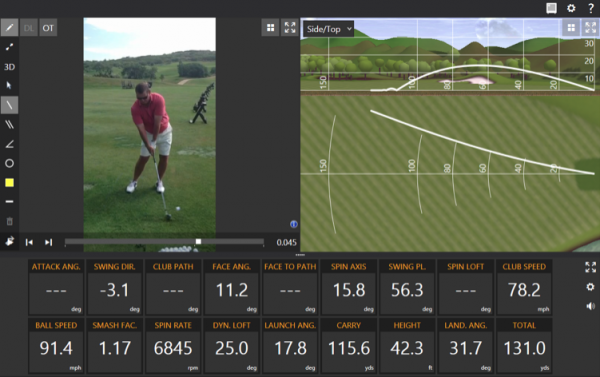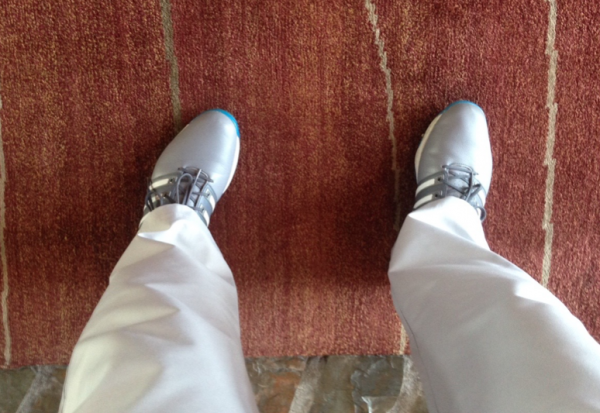Instruction
A fix for overactive hips, a cause of “The Flip”

As we all know, the golf swing is powered from the ground up, but many golfers take that too far — particularly when it comes to hip action.
Hip action is an important factor for controlling the low point and impact alignments of a golf swing, but when it’s overused it can cause the lower body to outrun the the upper body and create impact issues and severe mishits. So how do you fix excessive hip use? I’ve used my teaching tools, including Trackman data from a recent lesson, to explain.
In this sample swing, you can see that this student’s hips have slid too much laterally — they’re way past the vertical yellow line that I drew. This caused the student’s head to stay back in an effort to counterbalance his body movement. When this occurs, the right shoulder dives downward for too long in the downswing, and the low point shifts rearward. The move also causes the golfer’s pivot to stall, and his hands had to fire early in effort to move the low point father forward so he didn’t hit behind the ball.
You know the shot I’m talking about. With an iron, it causes very thin contact that sounds “clicky” and has little compression.
When golfers make this move, the ball will usually fly wildly offline since the flip interrupts the normal closing rate of the club face. Dynamic loft and vertical impact points will be compromised because of the flip move as well. It’s not a great combination, wouldn’t you agree?
So what’s the solution?
The best way to combat this type of swing is to reduce hip action by hitting small shots with your left foot turned in to feel yourself posting up more through impact. When you do this, your rear shoulder will move more “down and out,” which moves moving your low point more forward through impact without the need for any make-up moves.
A Word of Caution: When doing this drill, only swing at slow-motion speed. Hitting full speed shots like this may cause injury to your left knee.
When you turn your left foot inward, you’ll feel the instant posting up of your lower body. From there, it’s up to you to move the right shoulder through impact so the pivot of the upper body will continue to “pull” the arms and hands through. In order to do this, you’ll need to feel like you’re hitting low punch shots, which will cause you to increase shaft lean at impact. It will also reduce your dynamic loft by adding more compression.
Remember, this is a two-fold process:
- You must slow the hips.
- The upper body pivot must drive the arms through impact, leaning the shaft more forward.
Once you have this feeling at partial speed, work up to full speed with this same type of connected, punch-shot feeling until you can do it at Mach 1 with your driver!
- LIKE74
- LEGIT20
- WOW9
- LOL11
- IDHT7
- FLOP9
- OB10
- SHANK132
Instruction
Clement: Weak grips are injuries in the making for many golfers

Like Jordan Spieth, trying to go to a bowed wrist at the top or in the downswing to square the club is placing you in a dangerous position for your lead wrist; you are one tree root or deep rough situation away from a nasty injury that could easily require surgery. Don’t let this be you.
- LIKE1
- LEGIT0
- WOW0
- LOL0
- IDHT1
- FLOP2
- OB0
- SHANK3
Instruction
Clement: Laid-off or perfect fade? Across-the-line or perfect draw?

Some call the image on the left laid off, but if you are hitting a fade, this could be a perfect backswing for it! Same for across the line for a draw! Stop racking your brain with perceived mistakes and simply match backswing to shot shape!
- LIKE2
- LEGIT0
- WOW0
- LOL0
- IDHT0
- FLOP0
- OB0
- SHANK1
Instruction
The Wedge Guy: The easiest-to-learn golf basic

My golf learning began with this simple fact – if you don’t have a fundamentally sound hold on the golf club, it is practically impossible for your body to execute a fundamentally sound golf swing. I’m still a big believer that the golf swing is much easier to execute if you begin with the proper hold on the club.
As you might imagine, I come into contact with hundreds of golfers of all skill levels. And it is very rare to see a good player with a bad hold on the golf club. There are some exceptions, for sure, but they are very few and very far between, and they typically have beat so many balls with their poor grip that they’ve found a way to work around it.
The reality of biophysics is that the body moves only in certain ways – and the particulars of the way you hold the golf club can totally prevent a sound swing motion that allows the club to release properly through the impact zone. The wonderful thing is that anyone can learn how to put a fundamentally sound hold on the golf club, and you can practice it anywhere your hands are not otherwise engaged, like watching TV or just sitting and relaxing.
Whether you prefer an overlap, interlock or full-finger (not baseball!) grip on the club, the same fundamentals apply. Here are the major grip faults I see most often, in the order of the frequency:
Mis-aligned hands
By this I mean that the palms of the two hands are not parallel to each other. Too many golfers have a weak left hand and strong right, or vice versa. The easiest way to learn how to hold the club with your palms aligned properly is to grip a plain wooden ruler or yardstick. It forces the hands to align properly and shows you how that feels. If you grip and re-grip a yardstick several times, then grip a club, you’ll see that the learning curve is almost immediate.
The position of the grip in the upper/left hand
I also observe many golfers who have the butt of the grip too far into the heel pad of the upper hand (the left hand for right-handed players). It’s amazing how much easier it is to release the club through the ball if even 1/4-1/2″ of the butt is beyond the left heel pad. Try this yourself to see what I mean. Swing the club freely with just your left hand and notice the difference in its release from when you hold it at the end of the grip, versus gripping down even a half inch.
To help you really understand how this works, go to the range and hit shots with your five-iron gripped down a full inch to make the club the same length as your seven-iron. You will probably see an amazing shot shape difference, and likely not see as much distance loss as you would expect.
Too much lower (right) hand on the club
It seems like almost all golfers of 8-10 handicap or higher have the club too far into the palm of the lower hand, because that feels “good” if you are trying to control the path of the clubhead to the ball. But the golf swing is not an effort to hit at the ball – it is a swing of the club. The proper hold on the club has the grip underneath the pad at the base of the fingers. This will likely feel “weak” to you — like you cannot control the club like that. EXACTLY. You should not be trying to control the club with your lower/master hand.
Gripping too tightly
Nearly all golfers hold the club too tightly, which tenses up the forearms and prevents a proper release of the club through impact. In order for the club to move back and through properly, you must feel that the club is controlled by the last three fingers of the upper hand, and the middle two fingers of the lower hand. If you engage your thumbs and forefingers in “holding” the club, the result will almost always be a grip that is too tight. Try this for yourself. Hold the club in your upper hand only, and squeeze firmly with just the last three fingers, with the forefinger and thumb off the club entirely. You have good control, but your forearms are not tense. Then begin to squeeze down with your thumb and forefinger and observe the tensing of the entire forearm. This is the way we are made, so the key to preventing tenseness in the arms is to hold the club very lightly with the “pinchers” — the thumbs and forefingers.
So, those are what I believe are the four fundamentals of a good grip. Anyone can learn them in their home or office very quickly. There is no easier way to improve your ball striking consistency and add distance than giving more attention to the way you hold the golf club.
More from the Wedge Guy
- The Wedge Guy: Golf mastery begins with your wedge game
- The Wedge Guy: Why golf is 20 times harder than brain surgery
- The Wedge Guy: Musings on the golf ball rollback
- LIKE93
- LEGIT16
- WOW6
- LOL1
- IDHT0
- FLOP4
- OB1
- SHANK9
-

 Product Reviews1 week ago
Product Reviews1 week agoThree Swing Challenge: Testing the Edel Array F-2 putter
-

 Equipment1 week ago
Equipment1 week agoWhat clubs do equipment free agents choose to use on tour? We found out
-

 19th Hole3 weeks ago
19th Hole3 weeks ago‘You’re right, we’re always wrong!’ – Sergio Garcia receives warning during Open qualifier
-

 News2 weeks ago
News2 weeks agoHighlights from the Wilson Golf Product Testing and Fitting Experience at Pinehurst
-

 News2 weeks ago
News2 weeks agoDavis Thompson’s winning WITB: 2024 John Deere Classic
-

 Equipment3 weeks ago
Equipment3 weeks agoQ&A: The truth behind Bryson DeChambeau’s new Avoda irons from company founder Thomas Bailey
-

 19th Hole2 weeks ago
19th Hole2 weeks agoMajor champ ‘disappointed’ not to be chosen as U.S. Ryder Cup captain
-

 Whats in the Bag3 weeks ago
Whats in the Bag3 weeks agoCam Davis’ winning WITB: 2024 Rocket Mortgage Classic






















JP K
Jul 15, 2015 at 7:39 pm
Extremely impractical advice. Why not use “the marching move” which you can easily incorporate into the swing and take to the course much like 14 of 17 multiple major winners have?
Rob
Jul 14, 2015 at 4:33 pm
Wow, so many people must have missed the point of this article judging by the number of shanks.
Reducing hip action means reducing the lateral slide of the hips, not slowing down the rotation of the hips. Two totally different things.
dr bloor
Jul 12, 2015 at 11:57 am
Actually, it can be as big a problem for hitters as golfers. If your hips “fly open” through your swing, you’re more vulnerable to losing a lot of power and/or making a lot of weak contact, probably to the right side (for right-handed hitters).
other paul
Jul 11, 2015 at 2:16 am
I started rotating my hips as fast as I can and am doing the opposite of this article and I gained 25 yards on every club in the bag. No flip, just a rotational swing with very little slide.
I suspect people who are reading the same articles I am clicked shank…
Tom Stickney
Jul 11, 2015 at 12:09 am
Forget the photo of Hunter. It does not show what the article is about
Ryan
Jul 9, 2015 at 8:00 pm
So Hunter Mahan flips ?
may be typos
Jul 10, 2015 at 8:44 pm
To a degree, I’m sure everyone does
You gotta release sometime
gdb99
Jul 9, 2015 at 5:03 pm
Can’t wait to get to the range to try this!
I can feel my hips sliding forward instead of turning, and my hips are always tight after playing a couple days in a row.
Thanks!
Tom Stickney
Jul 9, 2015 at 2:48 pm
One last note…never hit full speed shots with any club with your left foot turned in.
Nolanski
Jul 9, 2015 at 2:12 pm
Great read. I always had my front foot turned open slightly per Hogan’s Five Lessons book. But it just wasnt for me because my hips would just fly open.